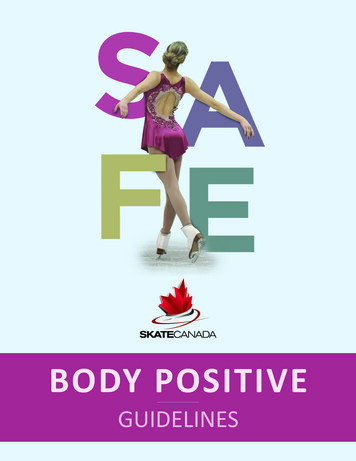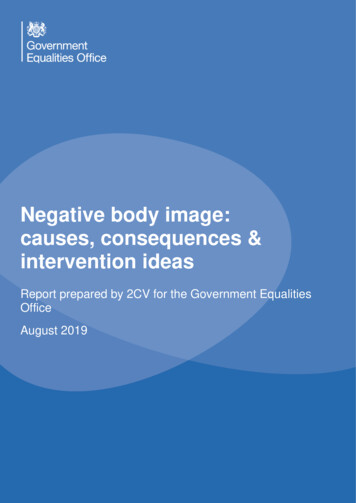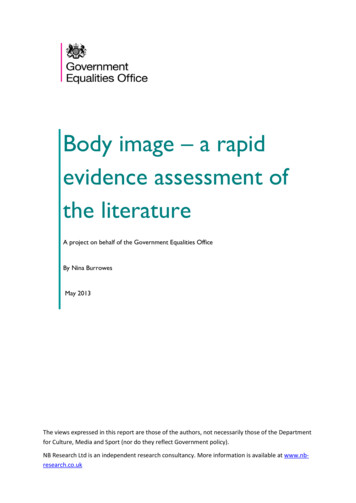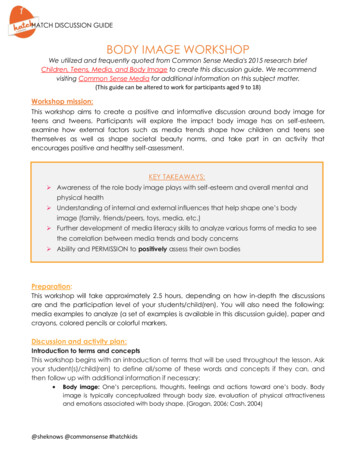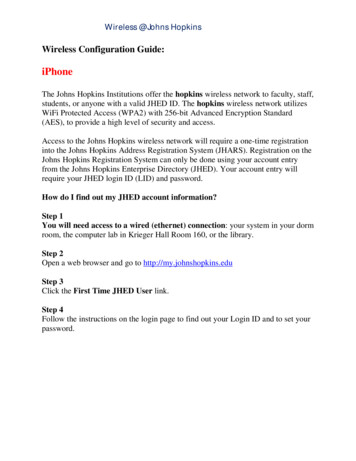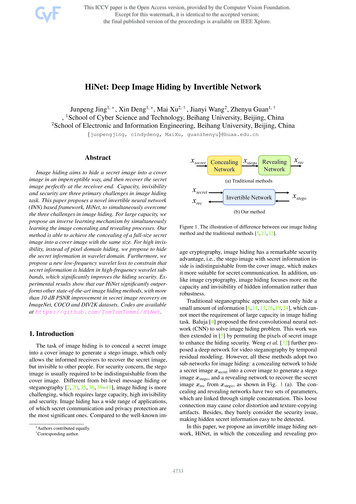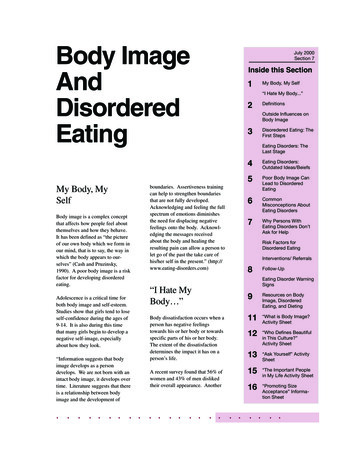
Transcription
Body ImageAndDisorderedEatingBody image is a complex conceptthat affects how people feel aboutthemselves and how they behave.It has been defined as “the pictureof our own body which we form inour mind, that is to say, the way inwhich the body appears to ourselves” (Cash and Pruzinsky,1990). A poor body image is a riskfactor for developing disorderedeating.“Information suggests that bodyimage develops as a persondevelops. We are not born with anintact body image, it develops overtime. Literature suggests that thereis a relationship between bodyimage and the development of.1.My Body, My Self“I Hate My Body.”2DefinitionsOutside Influences onBody Image3Disoredered Eating: TheFirst StepsEating Disorders: TheLast Stage4Eating Disorders:Outdated Ideas/Beiefs5Poor Body Image CanLead to DisorderedEating6CommonMisconceptions AboutEating Disorders7Why Persons WithEating Disorders Don’tAsk for HelpRisk Factors forDisordered EatingInterventions/ Referrals8Follow-UpEating Disorder WarningSigns“I Hate MyBody ”Adolescence is a critical time forboth body image and self-esteem.Studies show that girls tend to loseself-confidence during the ages of9-14. It is also during this timethat many girls begin to develop anegative self-image, especiallyabout how they look.Inside this Sectionboundaries. Assertiveness trainingcan help to strengthen boundariesthat are not fully developed.Acknowledging and feeling the fullspectrum of emotions diminishesthe need for displacing negativefeelings onto the body. Acknowledging the messages receivedabout the body and healing theresulting pain can allow a person tolet go of the past the take care ofhis/her self in the present.” (http://www.eating-disorders.com)My Body, MySelf.July 2000Section 79Resources on BodyImage, DisorderedEating, and DietingBody dissatisfaction occurs when aperson has negative feelingstowards his or her body or towardsspecific parts of his or her body.The extent of the dissatisfactiondetermines the impact it has on aperson’s life.11“What is Body Image?Activity Sheet12“Who Defines Beautifulin This Culture?”Activity Sheet13“Ask Yourself” ActivitySheetA recent survey found that 56% ofwomen and 43% of men dislikedtheir overall appearance. Another15“The Important Peoplein My Life Activity Sheet16“Promoting SizeAcceptance” Information Sheet. .
BODY IMAGE AND EATING DISORDERSDisordered Eating - Any abnormal eating pattern, ranging from less extreme to extreme behaviors. Disordered eatingincludes a collection of interrelated eating habits; weight management practices; attitudes about food, weight andbody shape; and physiological imbalances. Disordered eating includes classic eating disorders (anorexia nervosa,bulimia nervosa, and binge eating disorder) as well as eating patterns of lesser severity.Eating Disorder - An extreme expression of a range of weight and food issues, experienced by men and women.They include anorexia nervosa, bulimia nervosa, and compulsive overeating or binge eating disorder. All are seriousemotional problems that can have life-threatening consequences.Anorexia Nervosa - An intense and irrational fear of body fat and weight gain, a strong determination to becomethinner and thinner, and misperception of body weight and shape to the extent that the person may feel or see fatwhen emaciation is clear to others. Symptoms of anorexia include a refusal to maintain weight at or above a minimallynormal weight for height and age, an intense fear of weight gain, distorted body image, the loss of three consecutivemenstrual periods, and an extreme concern with the body weight and shape. Anorexia nervosa has the highestmortality rate of all psychological disorders.Bulimia Nervosa - Self-perpetuating and self-defeating cycles of binge eating and purging. During a “binge,” theperson consumes a large amount of food in a rapid, automatic, and helpless fashion. This may anesthetize hunger,anger, and other feelings but it eventually creates physical discomfort and anxiety about weight gain. The food is then“purged,” usually by induced vomiting and by some combination of restrictive dieting, excessive exercising, laxatives,and diuretics.Binge Eating Disorder - Also called compulsive overeating, characterized primarily by periods of impulsive gorging orcontinuous eating. Binge eating involves eating an amount of food in a specified time period that is larger than thatwhich most individuals would consume during a similar time period, and feeling a lack of control over eating duringthe binge. While there is no purging, there may be sporadic fasts or repetitive diets. Body weight may vary fromnormal to mild, moderate, or severe obesity.study found that girls as young as 9expressed concern that they weretoo fat and were afraid of becoming fat as they got older.appearance. After their heightspurt, females accumulate fatrapidly, especially in their hips,thighs, and buttocks. Girls whomature early may be more dissatisfied with their appearance andhave a poorer body image; theyfrequently need more reassurancethat they are developing normally.Many normal-weight adolescents,especially girls, are dissatisfiedwith their body shape and weight.Disturbance in body image is awidespread societal phenomenonlinked to a variety of psychosocialdifficulties and disorders includingdepression, social anxiety, eatingdisturbances, and low self-esteem.Outside Influenceson Body ImageIt is difficult not to notice or beaffected by the constant mediamessage that one must be thin tobe beautiful. Models in the 1950sand 1960s weighted 10% less thanthe average female; models in the1980s weighed 40% less.Boys have a mild weight increasebefore their growth spurt (around9-13 years of age). This prepubertal weight gain is morepronounced in some males andmay trigger a fear of becoming fat.Generally, the increased height andmuscular development that occurwith later adolescence usuallyimprove body image. In an attemptto build muscles, some boys mayPhysical body changes that occurwith puberty can influence anadolescent’s satisfaction with theirpersonal appearance. A girl’sphysical maturation may lead togreater dissatisfaction with her7-2use supplements (creatine, protein,etc.) or anabolic steroids.Although the media is heldresponsible for setting unrealisticstandards for the ideal body, it isnot the sole source of body imagedistortions.
BODY IMAGE AND EATING DISORDERS Children and adolescents oftenfeel personal pressure as parents,teachers, coaches, and friends urgethem to achieve the “perfect” body.meals, high fat and high caloricconsumption, and compulsiveover-exercising.“The overriding (media)message is that we need tochange something aboutourselves in order to be loved Adults themselves often modelbody dissatisfaction by makingnegative comments about other’sor their own bodies.Just because someone does not fitthe strict definition for a classiceating disorder does not mean theydon’t have a problem. Unhealthydieting or anorexic/bulimicbehaviors that are not frequent orintense enough to meet the formaleating disorder criteria may stillhave harmful short-term consequences and may lead to thedevelopment of more severe eatingdisorders (Newmark-Sztainer,1996).or successful. In particular, ifwe have thin, fit bodies, ourlives will be perfect. Thismessage is not true. Theconstant striving for something The majority of adult womenare “dieting” to lose weight,whether they need to or not.other than what we are is partof what may keep us dissatisfied with life. Fat children and adults aresocially isolated and are viewed asindividuals who have failedthemselves or society.“The reality is that geneticallywe are all born with varyingshapes and sizes. Less than5% of the population (geneti- “Fear of becoming fat” hasbecome a common phenomenon ina society that worships thinness.The prevalence of disorderedeating is disturbingly high amongadolescents and pre-adolescents.Children as young as 5 talk aboutdieting to lose weight.cally and healthfully) canexpect to achieve the shapeand size the media portrays asideal. The media holds thisAll teens are at risk for developinga poor body image in our culture.The media and advertising industrycan have serious and detrimentaleffects on a teen’s self image.Regardless of what teens are toldby educators and parents abouttheir looks, these messages arecontradicted by what they see ontelevision and movies, and inmagazines.unrealistic goal up to us andsuggests that we try to reachit. No wonder so many men adbody image /.Anyone can develop an eatingdisorder. Males and females andall social and economic classes,Faces, and intelligence levels areaffected. Over the past decade,white, middle-to-upper classfemales ages 13 to 30 have beenmost affected. True eatingdisorders are relatively uncommon:Only 5% of adolescents withdisordered eating behaviors go onto develop classic eating disorders.DisorderedEating: The FirstStepsBody Wise, a web site whichteaches girls the skills for healthyliving, found that one-third of the9th - to 12th-grade girls surveyedfelt they were overweight, and60% said that they were trying tolose weight. A recent article inPeople magazine stated that someteens don’t realize that it isn’tnormal to hate their bodies(Hubbard, 1999).Eating Disorders:The Last Stagewomen are struggling withDisordered eating includes a widerange of eating behaviors that caneventually lead to more seriouseating disorders such as anorexianervosa, bulimia nervosa, andbinge eating disorder. Disorderedeating can be identified by a groupof unhealthy weight loss methodssuch as: extreme caloric restriction,food group elimination skipped. .While there is no single event orfactor that causes an eatingdisorder, most professionals agreethat dieting precedes the onset ofmost cases (http://www.laureate.com).7-3
BODY IMAGE AND EATING DISORDERSEating disorders are a vanityissue.Adolescent females frequentlybegin to diet after the onset ofpuberty. Early-maturing femalesmay be even more likely to diet.Overweight females are also atincreased risk of dieting and usingunhealthy weight loss practices(see Section 8: Weight Management guidelines.Dieting is an appearance or vanityissue. Many eating disorders maystart out as dieting, but thebehavior turns quickly to copingmechanism for dealing with stress,self-hate, hurt, and shame. Eatingdisorders are not just aboutappearance.This is a sad false fact. Peoplesuffering with compulsive overeating disorder use food as a wayto fill a psychological void, to copewith stress, to take away pain, tocomfort themselves. For some, it’salso a way to keep from beingvulnerable. if they stay overweight, no one will want to getclose to them.Adapted from Eating DisordersShared Awareness,www.something-fishy.orgOnly “young, white females” geteating disorders.Anyone can develop anorexia orbulimia. Regardless of previouslyheld beliefs, young, middle-class,white teenagers or college studentsare not the only ones who cansuffer. Eating disorders affectindividuals from every age bracket,class, culture, and race.Doctors do not know everything.Unfortunately, in most places,unless they have taken additionaltraining on how to recognizeeating disorders or havespecialized in this field, theygenerally know very little aboutthem. A great number of doctorsare not aware of all the warningsigns or will begin testing for otherpossible physical problemsinstead. Also, the human bodylearns to adapt to starvation andmalnutrition; unless they arespecifically geared towards eatingdisorders, ordinary blood testswill show little detrimentalinformation.Not true! There are many anorexics, bulimics, and compulsiveovereaters who are of averageweight or above. The trulydevastating effects of eatingdisorders are usually invisible,such as nutrient deficiencies,electrolyte imbalances, and a hostof other physical dangers. Theoriginators for eating disorders —depression, low self-esteem and aninability to cope with stress —have little to do with one’s weight.Food and weight are symptoms ofcomplex emotional conflicts.The key to recovering from aneating disorder is to learn tomanage all areas of one’s life:stress, pain (past and present),emotions, and finally, eatinghealthfully. Learning not to usefood as a coping mechanism forthe underlying issues cannot beaddressed until the person beginsto address these issues. The earliera person gets help, the easier it willbe to treat the person and helpthem get well. When habitsbecome ingrained, eating disordersrequire lengthy treatment.If the doctor says there’snothing to worry about, thenthere isn’t.You can tell by looking whether aperson has an eating disorder.Concentrating only on the food is avery common mistake. Peoplewho suffer from eating disordersuse a negative coping mechanism— that just happens to involvefood — as a way to deal withunpleasant emotions. Buried deepdown inside each person is a cause,or group of causes and pains, thathave yet to be healed. These painshave compelled them to find analternative — and unhealthy —means of coping with life.Compulsive Overeaters are lazyand have no willpower.Eating Disorders:OutdatedIdeas/Beliefs7-4someone with bulimia. if I cankeep him/her out of the bathroom it will solve the problem. Iknow someone who is a compulsive overeater. a diet will fixeverything.Eating disorders are a woman’sillness.Absolutely not! Only recently hasthe media begun to address the“hidden population” of men witheating disorders. It is currentlyestimated that I in 10 individualswith an eating disorder is male,however given their reluctance toidentify themselves, the actualnumber of males with an eatingdisorder is probably greater.I know someone with anorexia.If I just get him/her to eat it willsolve the problem. I know.
BODY IMAGE AND EATING DISORDERSPoor Body Image Can Lead to Disordered EatingWhat models look likeWhat celebrities lookWhat parents sayWhat parents doWhat partner saysTV adsMessage fromcoachesPoor Body ImageMagazine imagesMessage from teachersMessage from peers Screen for signs ofdisordered eating. Refer to health careprovider who is experienced in treatin eatingdisorders.Screen for risk factorsfor developingdisordered eatingDisordered EatingCan lead to the development of classiceating disorders (anorexia nervosa,bulimia nervosa or binge eating disorder). .7-5
BODY IMAGE AND EATING DISORDERSCommonMisconceptionsabout EatingDisordersDisordered eating doesn’t alwaysmean restricting, bingeing, orPurging. If eating patterns ormeals consist of only lettuce, salad,or yogurt (or other comparably lowcalorie, low-fat foods), and thecalorie intake overall is far belownormal (and is combined withemotional attributes), this would beconsidered anorexia. The individual may not be “starving”themselves of food per se, but isrestricting themselves of any realcalories, substance, and nutrition.Adapted from Eating DisordersShared Awareness,http./www something-fishy. org“I cannot be anorexic because Ido eat when I have to.”Restriction of food does not meancomplete restriction. For some,this means restricting certain typesof foods and limiting calories tobelow normal on a daily basis. Forothers, this means fasting for acertain number of days and theneating “normally” for the next fewdays, and repeating the cyclecontinually.These dangers can include bowelor kidney dysfunction, brainshrinkage, dehydration, diabetes,TMJ (temporomandibular joint)syndrome, misalignment of theteeth, esophageal tears, stomachulcers, joint pain and arthritis,digestive and absorption problems,acid reflux disorders, cancer of themouth and throat, low or highblood pressure, heart arrhythmiaand cardiac arrest loss of menstrualcycle, infertility, dilation of theintestines, or depression and evensuicide.“My family member/friend eatsnormally around me. He/Shecan’t possibly have an eatingdisorder.”It is not uncommon for anorexics,bulimics, and compulsiveovereaters to eat “normally”around others. They may actuallylook forward to their time alone,however, to be able to “make upfor” the time they’ve spent“normally” around others. Once“I eat three meals a day (or I eata lot during the course of the.Vitamin/mineral supplements willnot protect against the physicaldevastation’s of an eating disorder.While taking vitamins and minerals may help to provide a sense ofsecurity, or even prolong certainaspects of health (such as wardingoff infection), they will not protectfrom the dangers associated withhaving an eating disorder.Eating disorders have thehighest rate of death of anypsychological illness. Asmany as 30% of thosesuffering from an eatingdisorder will die as a result ofcomplication caused by theillness.Many anorexics and bulimics arejunk-food addicts. These foodsmay serve as a false sense ofenergy and/or appease extremecravings. It is not uncommon tofind an anorexic or bulimic wholives solely on candy. Othercommon “replacements” are drugs,alcohol, coffee, tea, and/or cigarettes.“I take vitamin/mineralsupplements so I know I will stayhealthy.”“I can’t die from this.”“I eat a lot of candy, and can’tpossibly be anorexic.”.Anorexia, bulimia, and compulsiveovereating are not phases thatanyone just “goes through.” Somemay go through dieting phases, butthis is far different from having aneating disorder.There are other methods ofpurging” following a binge. Inaddition to laxative use or inducedvomiting, Purging can also beaccomplished with compulsiveexercise or complete fasting.Often times when anorexics cannotavoid a meal or food they willfollow any consumption with selfinduced vomiting or laxativeabuse. This is considered “anorexia, purging type.”.“This is just a phase.”“I don’t make myself vomit oruse laxatives. I can’t bebulimic.”“I don’t fit any category. . I onlyeat when I absolutely have to(but I don’t binge) and thenpurge whatever I do eat.”7-6they have gotten back into theirsolitary environment, anorexicswill completely starve themselves,bulimics will binge and purge, andcompulsive overeaters will binge.day) and never purge. How can Ihave an eating disorder?”.“Everyone who is overweight orfat is a compulsive overeater.”What defines the illnesses ofcompulsive overeating or bingeeating disorder is more than justthe weight range of the individual.
BODY IMAGE AND EATING DISORDERS“My therapist refuses to treat mebecause I’ve lost (gained) weight.’Emotional eating, eating to fill avoid, staffing down feelings withbingeing, isolation, and pushingothers away are just some of thetraits. There are other reasons anindividual can be overweight,including medical reasons or agenetic predisposition to a largerbody size.“I’m a man and I know they’ll thinkI’m a freak, or they won’t believeme.”“The doctor won’t take thisseriously, no one else does.”Low self-esteem-Poor body image-Focus on weight-Exercising to extremes-Self-mutilationUse the “More About Body Image, Eating Disorders, and Dieting”information sheet for other sources of information on these topics.“He/She will tell my parents.”Use the “The Important People in My Life” information sheet to assistyour client with value clarification“People will find out.”“He/She will just see me as fat,they won’t believe it’s an eatingdisorder.” (CompulsiveOvereater)Use the “Promoting Size Acceptance” activity sheet to discuss sizeacceptance with clients.IF YOU SUSPECT THAT THE CLIENT HAS AN EATING DISORDER, REFER HER TO A HEALTH CARE PROFESSIONALOR AGENCY THAT SPECIALIZES IN THE TREATMENT OFEATING DISORDERS. FOR REFERRAL INFORMATION, SEE“MORE ABOUT BODY IMAGE, DISORDERED EATING, ANDDIETING.”‘The doctor is just going to makeme gain (lose) weight!”“My doctor (therapist) will tell meto ‘just eat’ but it’s so much morethan that!”.Family dysfunction-Stop the videotape before the “Resistance and Change” section and usethe “Ask Yourself’ activity sheet as an interactive activity that encourages client self-assessment of attitude.“The doctor won’t take mycomplaints seriously, He/Shethinks I’m too young to be worriedabout such things.”.-Stop the videotape before “What Do We Do With the Message” sectionand use the “What Is Body Image?” activity sheet as an interactive withclients.“I’m not sick enough. He/Shewon’t think I need help.”.Family history of disorderedeatingUse the BodyTalk video to educate clients on the role of media andculture in the development of attitudes on body image“I’m not thin enough. He/Shewon’t believe me.”.-Interventions/ ReferralsAdapted from Eating SharedAwareness, http://www.somethingfishy-org.Adapted from Mary-Ann Shafer,MD, Hidden Epidemic Seminar,1999It’s vitally important that healthcare providers learn to recognizethe physical signs of eatingdisorders and to validate theemotional turmoil experienced bythose suffering from them. It isalso important to know that therecan be many co-existing psychological illnesses and/or addictionsto alcohol or drug abuse.Why Persons withEating DisordersDon’t Ask forHelp.Risk Factors forDeveloping DisorderedEating. .7-7
BODY IMAGE AND EATING DISORDERSFollow-UpLet the client know that there ismore than one way to be beautiful!Discuss the client’s answers to thequestions on the “What Is BodyImage” and the “Ask Yourself’activity sheets. Use the answers tohelp the client evaluate how herbody image is influenced byinternal and external messages.Awareness of the type of messages(positive and negative) shereceives is the first step towardchange. Help the client understand that Reinforce messages learned inthe Body Image and Disordered Eating guidelineactivities.her self-perceptions may bereactions to the negative mediaimages she receives aboutbody image. Encourage the client todiscuss the origins of bodydissatisfaction and eatingdisorders in social settings, sothat she can compare herresponses to those of herpeers. Encourage acceptance of allbody types. Eating Disorder Warning SignsAdapted from Judith Levine, RD, MS, “Helping your Child Lose Weight the Healthy Way, “ 1996Warning SignLarge, rapid weight loss (more than 4 pounds in one month)AnorexiaNervosaBulimiaNervosaXXGreat fluctuations in body weightBinge EatingDisorderXXExcessive or compulsive exercisingXXPreoccupation with dieting and weight lossXXXPreoccupation with eating and foodXXXDistorted body image; feels fat even when thinXXRefuses to eat, eats tiny portions, and/or denies hungerXXConsumes unusually large quantities of foodXXXEats by herself or is secretive about foodXXEats only a few types of foods; avoids entire food groups orhas suddenly become vegetarianXXDisappears after eating, usually to the bathroomXDevelops dental problemsXHas irregular menstrual cycles or has not menstruated fortwo months or longerXXHas swollen salivary glands or puffy cheeksXIs depressed, moody, or insecureXXPurchases laxatives or diet pillsXXStops participating in normal activitiesXXXXXSteals food or money to buy food7-8.X.
BODY IMAGE AND EATING DISORDERSResources on Body Image, Disordered Eating, and DietingTreatment Centers and ReferralsMore Information on Disordered EatingChild Health and Disability Program (CHDP)Look in your local phone book under the GovernmentListings, Health and Human Services section, for yourlocal CHDP program (accepts Medi-Cal)American Dietetic AssociationNational Center for Nutrition & Dietetics216 West Jackson Blvd., Suite 800Chicago, IL 60606312-899-0040Nutrition Hotline: 800-366-1655http://www.eatright.orgLucile Salter Packard Children’s HospitalAt Stanford-Disordered Eating Program725 Welch RoadPalo Alto, CA 94304650-498-4468(Accepts Medi-Cal)American Anorexia/Bulimia AssociationC/O Regent Hospital293 Central Park West, Suite I RNew York, NY 10024212-575-6200UCLA Neuro-Psych-InstituteEating Disorder Program760 Westwood PlazaLos Angeles, CA 90024310-825-9989Eating Disorders Awareness and Prevention603 Stewart Street, Suite 803Seattle, WA 98101Phone 206-382-3587Fax 206-292-9890Eating Disorder Center of CaliforniaOffices in Malibu, Westlake Village,West LA, and Santa Barbara310-457-9958National Association of Anorexia Nervosa andAssociated DisordersBox 7Highland Park, IL 60035847-831-3438Fax 847-433-4632Monte Nido Treatment Facility514 Live Oak CircleCalabasas, CA 91302818-222-9534 or 310-457-9958National Eating Disorders Organization6655 South Yale AvenueTulsa, OK 74136918-481-4044Disordered Eating ReferralCalifornia Dietetic AssociationNancy King, RD (Registered Dietitian)818-957-8588The National for Center Overcoming OvereatingP.O. Box 1257, Old Chelsea StationNew York, NY 101 13-0920212-875-0442Tami Lyon, RD415-896-5859. .7-9
BODY IMAGE AND EATING DISORDERSBooksOther ResourcesCash, T. The Body Image Workbook.- An 8-step programfor learning to like your looks. New Harbinger Publications, 1997.American Anorexia/Bulimia Association (ANRED) 165West 46h Street, Suite II 08New York, NY 1003 6212-575-6200http://www.anred.com/Cash, T. Pruzinsky, T. Body Images: Development,Deviance, and Change. Guilford Press, 1990.Public Health Service’s Office on Women’s Health U.S.Department of Health and Human Services 200 Independence Avenue, S.W., Room 730B Washington, D.C.20201 http://www.whealth.org/links/Cooke, K. Real Gorgeous. New York: W.W. Norton &Co, 1996.Fraser, L. Losing It: America’s Obsession with Weightand The Industry That Feeds on It. New York: Dutton,1997.yourSelfA fun website on nutrition and physical activity createdby and for teenshttp://151.121.3.25/rr/Hesse-Biber, S. Am I Thin Enough Yet? New York:Oxford University Press, 1996.Overeaters Anonymous HeadquartersWord Services OfficeP.O. Box 44020Rio Rancho, NM orgHirschmann, J.R. Munter, C.H. @en Women StopHating Their Bodies. New York: Fawcett Coumbine,1995.Hutchinson, M. Transforming Body Image: Learning toLove the Body You Have. Crossing Printing, 1988.Body image and the mediahttp://www.about-face.orgMiller, W. Negotiated Peace, How to Win the War OverWeight. Allyn & Bacon, 1997.Young women with power and attitudehttp://www.hues.netWolfe, N. The Beauty Myth. New York: William Morrow& Co, 199 1.Teens and Diets-No Weighhttp://www.hugs.comMost of the books listed above, as well as others, areThe Center for Eating Disordershttp://www.eating-disorders.comavailable through the Gurze Catalogue of Books onEating Disorders. For a free catalog, call (800) 7567533, or see their website at http://www.gurze.com7-10.Girl Power!http://www.health.org/gpower/bodywise.
BODY IMAGE AND EATING DISORDERSWHAT IS BODY IMAGE?(Adopted from BodyTalk facilitators guide-Corresponds to 1st segment of videotape ‘The Message’)Body image is the picture of your body that you hold in your mind.Body image is made up of many events in your life including:. How your family members react to your body How your body changes as you grow Any experience of physical or sexual abuse you may have had How your body feels How you feel about being a girl or boy Sports or movement classes in which you might participate Accidents and illnesses you may have had Your ethnicity and/or community Messages from media, such as television, magazines, and movies. .7-11
BODY IMAGE AND EATING DISORDERSWHO DEFINES BEAUTIFUL IN THIS CULTURE?Think about the messages you receive about your body and the food you eat from themedia, your family, your friends, and at school. How do those messages affect your bodyimage?Watch 30 minutes of television with a critical eye. Observe how overweight people areportrayed. What stereotypes are promoted?Have you ever calculated the amount of money and time you’ve spent in the past week onfashion or fitness magazines, beauty products, and weight loss or weight gain products?Time spent last week trying to change your body (hours) Amount spent last week on fashion/fitness magazine Amount spent last week on beauty products Amount spent last week on weight loss or weight gain products TOTAL amount of money spent last weekFigure out how much you would spend in one year to attempt to change your body. Total amount per week X 52 weeks per yearTime spent per week X 52 weeks hours per yearIf you accepted yourself as you are and stopped buying products with the idea of changing yourself, how much money would you save, and what would you do with it? Considerwhat you could do with all the time you spent as well.7-12.
BODY IMAGE AND EATING DISORDERSASK YOURSELFAdopted from BodyTalk facilitators guide.Corresponds to 2nd segment of videotape ‘What do We Do With the Message”How have you used food or eating to cope with bad feelings?What situations lead you to begin a diet?How do you feel emotionally and physically when you are dieting?How often do you eat when you are hungry, eat what your body wants, and stop whenyou are full?Observe the messages about beauty directed at you in your environment. Does the ideathat beauty comes in all sizes, shapes, and colors exist?What factors might contribute to the fact that 9 out of 10 people with eating disordersare female?. .7-13
BODY IMAGE AND EATING DISORDERSMake a list of the comments you have made about your body — both in your head and outloud — since you woke up this morning. Are these thoughts and comments negative orpositive? Identify the sources of any negative thoughts or comments.Observe how many times in one day you criticize other people’s appearances or bodies.How does this practice make you feel? How does it affect the people around you?What would you be free to do if you accepted your body?How would you feel if you really loved your body, even with all its “imperfections?”What are you going to do to help yourself and others to feel good about your bodies?7-14.
BODY IMAGE AND EATING DISORDERSTHE IMPORTANT PEOPLE IN MY LIFEHow much do looks real
“Information suggests that body image develops as a person develops. We are not born with an intact body image, it develops over time. Literature suggests that there is a relationship between body image and the development of boundaries. Assertiveness training can help to strengthen bound
